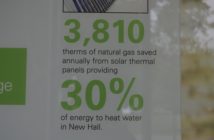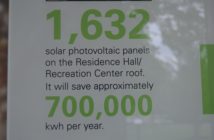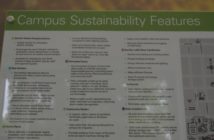A sustainable present
Professor Gregory Ruthig sits in his office in the Kroehler Science Center on the North Central College campus as the 2016-2017 school year comes to a close. Outside of his office sits two bins labeled “landfill” and “recycling,” just a small indicator of a larger movement on campus: one of taking measures to make North Central a more sustainable place to be.
What is sustainability? It seems like a simple question but that doesn’t always mean there is an easy answer, as Ruthig explained:
Audio PlayerHow can one define sustainability?
Sus·tain·a·bil·i·ty (səˌstānəˈbilədē): noun
- the ability to be maintained at a certain rate or level. “The sustainability of economic growth”
- avoidance of the depletion of natural resources in order to maintain an ecological balance. “The pursuit of global environmental sustainability”
This one word can mean so much to one person, and absolutely nothing to someone else. Despite this, with a single Google search, it is clear that sustainability is a popular term among the millennial generation. Searches for the term “sustainability” skyrocketed around the year 2000, steadily climbing since the 1980s.
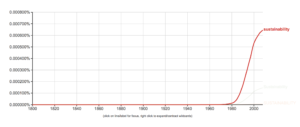
Photo by Google Books.
It is clear that as time goes on, sustainability is becoming an integral part of colleges across the nation. This focus on green intensified with the establishment of the AASHE, or the Association for the Advancement or Sustainability, in 2005. Dining, composting and water conservation are examples of initiatives that colleges can undertake in the realm of sustainability.
The Princeton Review published a list of the top 50 green colleges, and as the list goes on there are a number of commonalities the colleges share. At first glance at the top 20 on the list, size and location seem to play a role in a college’s ranking and effectiveness in sustainability.
Taking first place on the list is College of the Atlantic in Bar Harbor, Maine with an enrollment of 338. This can be seen repeating throughout the list, as the majority of colleges are located on the coasts and have a smaller enrollment size. This trend is broken with a few additions to the list from the midwest, including Loyola University of Chicago and University of Illinois at Urbana-Champaign.
What makes a sustainable college?
In an interview with The Princeton Review, representatives from the College of the Atlantic give their reasoning as to why the college’s implementation of environmental policies on campus are so successful, and what bolsters student involvement in these initiatives.
“The central focus of COA’s academic program is the interdisciplinary, experiential study of the interactions between humans and the environment,” said representatives. “This focus attracts students, faculty, and staff who have a strong commitment to sustainability, and due to the college’s intentionally small size (350 students), there is a strong culture of participation; you can’t really be at COA and not be involved in something having to do with sustainability.”
The highest rated college on the list located in the midwest is Oberlin College, located in the heart of Oberlin, Ohio. Like most of the other schools on the list, at the heart of their sustainability initiative is student and faculty participation and cooperation. They advertise this sentiment clearly on their website, stating that “partnership is key to our process.”
Keeping these facts in mind, how does North Central College fit into this sustainable vision? As of the 2016-2017 school year, the college’s enrollment rate stands at 2,962, putting them in the same realm as most of the institutions on The Princeton Review’s list.

North Central is in one of Chicago’s largest suburbs, Naperville. Photo by Google Maps.
The location of the college also puts it into an interesting position when comparing it to others on the list. Chicago is only a short train ride away from the campus, giving students and faculty easy access to the resources of one of the United States’ largest cities.
North Central’s sustainable past
North Central’s bid to be involved in the culture of sustainability started 15 years ago when a group of professors kick-started the environmental studies program, which was at that time non-existent. The start of this program aligns with the climb of sustainability to becoming a household term.
“There wasn’t one, so myself and a couple other faculty members here started it,” said Jeffrey Anstine, the coordinator of environmental studies. “Professor Bohrer in English, Professor Barnett in history, Professor Krystal in anthropology: the four of us started the program.”
In 2009, the focus on sustainability at the college grew with the hiring of sustainability co-ordinator Brittany Drummond. Preceding her hiring as a full-time staff member at the college, there were already steps being taken to become a more sustainable institution, as stated by Drummond in an interview:
Audio PlayerWhat started off as just composting at Kaufman evolved into composting at more locations on campus. There are multiple composting bins at the Cage, as well as in the new science center. Staff members of all disciplines can also request to have a composting bin in their office, giving them a new way to participate in the sustainable future of the college.
The waste management program at the college is another priority for the sustainability initiative. The main goal of this program is to increase the landfill diversion rate to 40 percent from the current rate of 28 percent. An increase in composting bins, as well as a buying ban on styrofoam products, are two of the tactics in the new program.
One of the more recent campaigns put into place by the NCCSI is the follow-me printing service that was implemented during the 2015-2016 school year. With this program in place, the college reduced their campus paper use by 30 percent.
- Photos by Kathryn Bloch.
How is sustainability central?
Drummond and Ruthig both point to the fact that they want more students involved in the initiative, and the department of communication and media is playing a key role in that wish. In the past, multiple classes have developed projects for the initiative.

One of the largest solar arrays in Illinois. Photo by Kathryn Bloch.
One of the biggest contributions to the initiative came from the Introduction to Public Relations class, taught byProf. Emily Cramer in the fall term of the 2016-2017 school year. Senior Riza Mae Enriquez took the course and was a member of the team with the best PR program plan to promote the installation of the solar photovoltaic array on the roof of the Residence Hall/Recreation Center and inform students and faculties about the benefits they would bring.
Prior to taking the course, Enriquez had little knowledge of the sustainability initiatives at the college and had no awareness of the solar PV array. “I was not aware of it until I got into Introduction to Public Relations, and my group was really motivated,” said Enriquez. “We wanted to get the facts right away.”
The impact of Enriquez and her group’s work can be seen in the new science center in the form of infographics, giving students passing through the halls a glimpse of what the installation of the solar panels means for the future of the college.
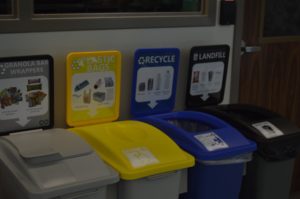
A staple on the college’s campus. Photo by Kathryn Bloch.
In the past, marketing classes also contributed to the initiative by providing qualitative research on what types of pictures would encourage students to take the timed and put the correct items in the correct bin. This culminated in the pictures that still adorn the recycling and trash bins on campus to this day.
A sustainable future
At the beginning of the 2017-2018 school year, environmental studies will be offered as a major at the college. This comes at an interesting, transitional time in the college’s history. At the beginning of the spring 2017 term, the new science center opened to students, giving them and STEM faculty a new place to call home on campus.
Gregory Ruthig, one of the environmental studies professors, hopes that the inclusion of the study as a major will peak the interest of non-STEM students:
Audio PlayerThere are a number of initiatives in the works at the college, but Ruthig ultimately wants to see a change in the culture of the college, and in the way that things develop and evolve in terms of sustainability. “We’re working hard to create a greater culture of (sustainability) on campus,” said Ruthig. “I might complain a little bit that a lot of the initiatives have come more from people like Brittany and even the faculty than they have been student-driven.”
In the future, Ruthig wants to see a shift in the way that change is made at the college. “I would rather see it from the bottom up,” said Ruthig. “I’d love to see students doing more than they are currently.”
Josie Woger, one of two students who works closely with Drummond, believes that sustainability is especially important to the college experience:
Sustainability and millennials
Sustainability is a part of the future just as much as it is a part of the present, not just at the college but in the world at large. In an article by Nielsen titled “Green Generation: Millennials Say Sustainability is a Shopping Priority,” their global team finds that millennials have a connection to sustainability. This connection manifests itself not only in the way that the generation acts, but also in the way that they spend their money.
“When it comes down to financial commitment, a sustainable sentiment shifts to one of increased social awareness and responsibility,” said Grace Farraj, the SVP of Public Development & Sustainability at Nielsen. “Marketers need to connect messaging with the causes that matter most to consumers and that also align with their brand.”
In recent Nielsen studies, these findings have been reinforced. A global online study states that over 50 percent of the consumers surveyed found that they were influenced by “sustainable factors” when considering what to purchase and from what companies. In the same vein, 56 percent of the surveyed were swayed if the “company (was) known for its commitment to social value.”
The heart of sustainability
One of the biggest events of the school year at the college is the Cornerstone picnic. Students, faculty and community members come together to celebrate the beginnings of North Central. At various points in the large
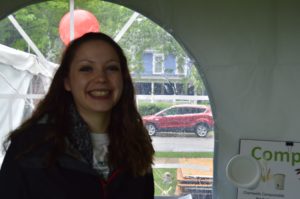
Gaither stands under the tent at Cornerstone. Photo by Kathryn Bloch.
tent on Jefferson Lawn stands volunteers helping guests sort their waste. One of those volunteers was Sarah Gaither.
The sustainability initiative has played an integral role in the college experiences of Gaither and Josie Woger, the two sustainability workers at the college. They work closely with Drummond on various parts of the sustainability initiative and volunteer at various campus events.
One of the main goals of any liberal arts college is to help provide students the life skills they need for life after college. That is something that Woger and Gaither have gained through the sustainability initiative, and hope that other students will as well.
“Sustainability is super important to participate in at the college level, because it’s where we start getting our habits for the future,” said Gaither. “So if we can get students involved and caring about sustainability and recycling, maybe they’ll carry those into their future lives.”
Editor’s note: all photo, video, audio and editing by Kathryn Bloch



